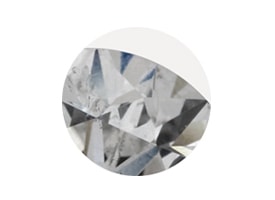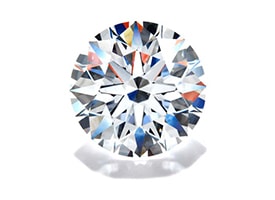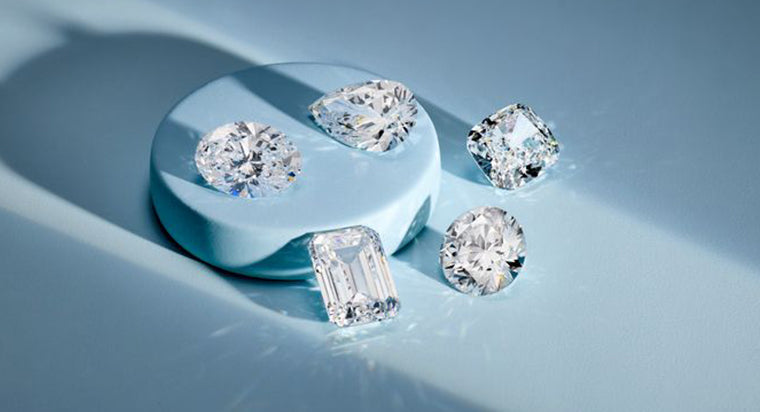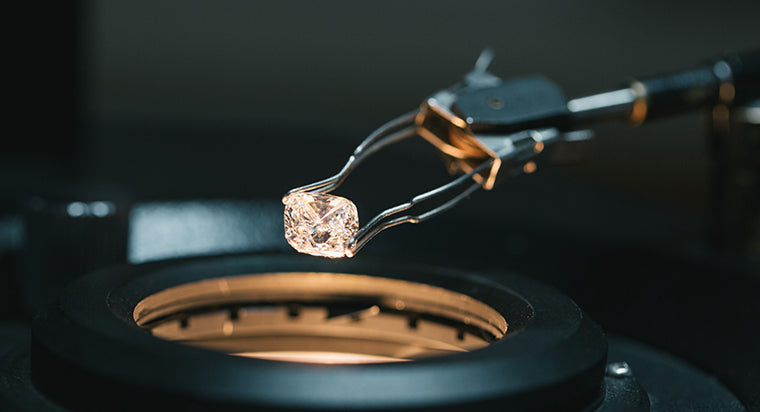AGS Diamond Certification

When investing in a purchase as significant and expensive as a diamond, a diamond grading report, or diamond certificate, is an important measure to ensure peace of mind. Although all diamond certificates provide a third-party validation of your jeweler's diamonds, not all certifications are the same.
TABLE OF CONTENTS
Diamond Certification
U.S. Diamond certificates typically come from one of three laboratories: the Gemological Institute of America (GIA), the American Gem Society (AGS), or the European Gemological Laboratory - USA (EGL or EGL USA).
- The GIA is the world's leading gemological laboratory and the industry's most trusted and popularly used laboratory.
- The AGS laboratory is the second most widely used diamond certification lab. The AGS is a nonprofit U.S. based diamond laboratory with global offices throughout Israel, Belgium, India, China and Hong Kong.
- The European Gemological Laboratory - USA (EGL or EGL USA).
Diamond Certification Differences
While the GIA is the industry's leading diamond lab, the AGS is not far behind. An AGS certificate is often considered far superior to an EGL certificate, which are typically known to be more lenient than the GIA or AGS, often reporting higher grades for the same diamond. In addition, many consumers often feel more comfortable purchasing GIA or AGS diamonds because unlike the EGL, the GIA and AGS are both non-profit organizations.
Diamond certifications vary between institutions because of differences in professional opinion, grading systems, and nomenclature. Unlike the GIA and EGL which use alphabetical diamond grading systems, AGS diamond grading uses a 0 to 10 scale, with 0 as the best and 10 as the worst. The GIA and EGL describe diamond color in three broad categories with alphabetical subdivisions: colorless (grades D, E, F), near colorless (G, H, I, J), and distinct color (K to Z). But because color grades are an educated opinion describing the amount of color present in a diamond, the difference in grading occurs when laboratories disagree on where each color grade should fall.
AGS Diamond Scales

Diamond Color Scale
The numerical AGS diamond color scale starts with 0 translating to a D grade, and increases by 0.5 for each letter increment. For example, an AGS diamond grading of 0.5 is a GIA/EGL grade of E. Thereafter, 1.0 is F and 1.5 is G. The scale ends with 9.5 as W and 10.0 encompassing X, Y, and Z.

Diamond Clarity Scale
The industry standard for diamond clarity grading is based on the GIA's alphabetical grading scale. The standard GIA clarity grading scale contains six main grades (from highest to lowest): FL, IF, VVS, VS, SI and I. FL (Flawless), diamonds don’t have flaws visible under 10x magnification. IF (Internally Flawless) diamonds have only insignificant surface blemishes. Then comes VVS (Very Very Slightly Included) and VS (Very Slightly Included) diamonds. Finally, there are SI (Slightly Included) and I (Included) diamonds, with the term “inclusion” referring to any diamond flaws. The EGL uses the same scale but includes their unique "SI3" clarity grading, an EGL-exclusive subdivision of the SI clarity range. This new grade caused concern because it added a new clarity grade that departed from the widely accepted GIA clarity scale which divides the SI grade into SI1 and SI2, with I1 as the next lowest grading after SI2. Although seemingly harmless, the new SI3 grade sparked controversy because unassuming customers may be purchasing an EGL SI3 diamond without realizing that it may be equivalent to a GIA I diamond instead of a SI diamond. This one grade difference is significant because SI diamonds may or may not have inclusions visible to the naked eye while I diamonds will usually have flaws that are easily visible, causing a significant price drop between the two categories. Although AGS certifications for clarity use a numerical grading scale, its grades can be easily converted. An AGS 0 is a GIA/EGL Flawless and Internally Flawless, 1 is VVS1, 2 is VVS2, 3 is VS1, 4 is VS2, 5 is SI1, 6 is SI2, 7 is I1, 8 is I1 and I2, 9 is I2 and I3, and 10 is I3.

Diamond Cut Scale
A similar pattern applies to the diamond cut scale. The GIA and EGL use a descriptive diamond cut scale: Ideal, Excellent, Very Good, Good, Fair, and Poor. The AGS numerical scale translates as follows: 0 (Ideal), 1 (Excellent), 2 (Very Good), 3 and 4 (Good), 5, 6, and 7 (Fair), and 8, 9, and 10 (Poor). While the unique numerical diamond grading scale of the AGS may seem unusual at first, it is actually a quite clean and simple way to understand your diamond. When purchasing diamonds, it is wise to research the laboratory behind your diamond certificate and their unique grading system.
Diamond Grading Process
During the grading process, the gems are graded on an electronic colorimeter, which is located at the headquarters of the AGS and is available to its members. A set of what is called; master diamonds are used to measure the quality of the diamonds. The master sets are color-graded diamond sets that are of differing grades and colors and are both owned and maintained by the members of diamond ratings committee. They are graded individually on the colorimeter that is at the headquarters. Their main purpose is to be used as comparison in the grading of the other diamonds.
These master sets are used for ensuring that the diamonds are graded as close to the master set as possible. They consist of a minimum of five stones measuring one-third of a carat, or a larger percentage. If a master set is unavailable, diamonds that have not been found similar to a part of a master set , or which had been graded on the colorimeter; can also be used as a comparison-grading tool, if the color, when seen by the eye, is closer to the color of the stone being compared upon examination. Diamond master sets, which have been graded on the colorimeter, are colorless and look yellow. If the diamond being compared has a green, brown, or yellow-looking body, then it is best to compare and grade it with a master diamond that has a yellow-looking color, but only the depth can be compared.
The grading process involves an ultraviolet-free daylight, or the equivalent and no reflection of color, the diamond that is being graded along with the master. The diamond and the one which is being assessed should be viewed along with the other from the master set, over a full white background. The direction should be perpendicular to that of the pavilion facets, or girdle. Small differences in color is detected by magnification. It also allows small areas to be examined on two stones to ensure that the comparison was done on the body color and not the reflected color.
Color Impact on AGS Grading Process
In order to ensure that you, the consumers get authentic and high quality diamonds, The American Gem Society was formed to oversee the process. The American Gem Society, or AGS as it is commonly known, was founded by a group of leading jewelers in 1934. With a goal of creating an organization that would assist in protecting consumers from less than accurate advertising of diamonds, and of fraud. They have superior skills in determining whether or not a gem is fake, or less than perfect. This has resulted in many unsuspecting consumers being saved from being robbed, because of their lack of knowledge in buying gems.
If you are going to buy an AGS diamond, do not look only at the way it sparkles, you have to request the AGS diamond grading report from the AGS. With this report, you, as the consumer, can then see for yourself, all the factors that contribute to it being a valuable diamond. The standards that are used by the AGS certification board to grade diamonds have made the process a lot easier, as they created standards by which the color, cut, and clarity are judged, on a scale of 0 to 10. The scale begins at 0, which is the highest grade and goes down to 10, which is the lowest. These three factors, when combined with the carats in the diamond, will produce the AGS grade.
The color is of utmost importance in the AGS certificate grading process, as it determines if the diamond is a 0 or a 10 on the grading scale and thereafter, the price is determined.
If the color grade of a diamond is 4, it means that it does not have as much color as one that has, let’s say a 6. If the color grade of the diamond is less, then it means that the diamond is rarer and therefore, is more expensive. With the AGS diamonds scale, the cut is determined first, then the color, the clarity and finally, the carat weight. If the diamond has the finest cut grade it can possess and is colorless as well, with no blemishes, or other imperfections, and the weight is one carat, then the notation would be (0/0/0-1.000) carats.
Grading Fancy Shaped Diamonds
The grading process for fancy shaped diamonds is somewhat different with AGS vs GIA, or the Gemological Institute of America, who grade them by comparing them with master diamond sets only, as fancy shaped diamonds are not any of the diamonds that are accommodated by the colorimeter. Color and clarity on a fancy cut diamond are also graded in similar ways as other diamonds. These shapes are viewed at an angle that is half way between the length and the width, as a means of providing a balance between the minimum and maximum length of the observer.
The grading is done from an angle of 45 degrees because it gives a more accurate reading on the exact color. Fancy shaped diamonds are known to accumulate color in locations, based on the arrangement and proportion of their facets, such as their height, thickness or crown. The arrangement of the facets can cause a serious impact in the color grade. Color zoning is also possible with fancy shaped diamonds.
Fluorescence Impact on AGS Grading Process
One important aspect of the color grading process to get a certified diamond, is the assessment of the fluorescent in a diamond. A small percentage of the diamonds being sold has around 35% of fluorescence, according to AGS. If the diamond is exposed to ultraviolet lighting, they will reflect different colored lighting. Even though fluorescence is just a characteristic which identifies the diamond, in some instances the appearance can also be impacted. The diamond is placed in a face-up position and fluorescent master stones are used in the assessments. When this is done, the diamond's fluorescence will occur at different angles and can be less, or more visible, depending on the angle from which it is viewed.









